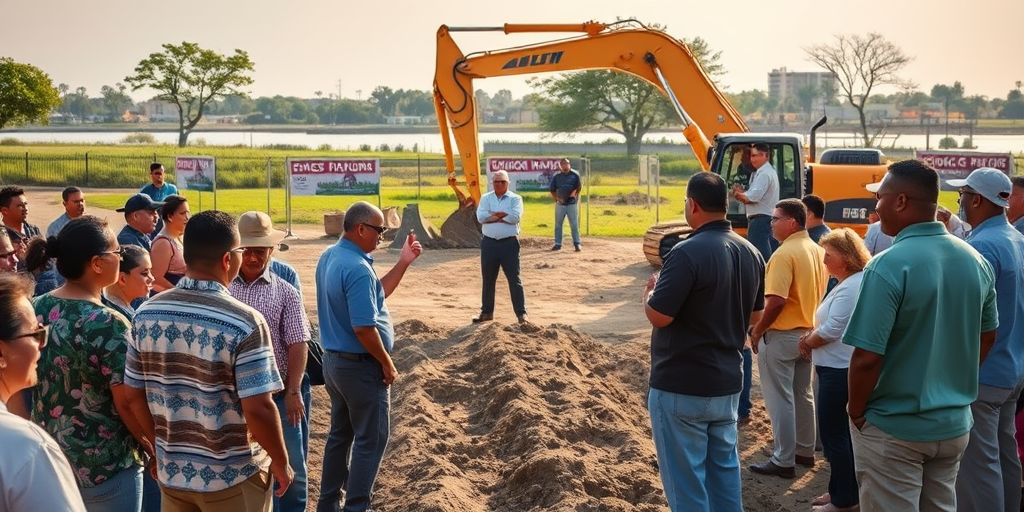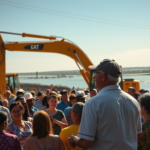McAllen Breaks Ground on $180 Million Groundwater Project
In a landmark initiative for South Texas, the city of McAllen has launched a massive groundwater project aimed at diversifying its water sources amidst ongoing droughts and longstanding water debt issues with Mexico. This ambitious undertaking, projected to cost around $180 million, represents the most significant investment in utility infrastructure in the city’s history, underscoring its importance for Rio Grande Valley (RGV) residents.
Background and Impetus for the Project
For decades, the Rio Grande has been the primary water source for McAllen and surrounding areas. However, with persistent drought conditions and Mexico’s failure to repay overdrawn water quotas, local officials have sounded the alarm over the region’s water security. As McAllen Utilities Director Mark Vega puts it, “Right now McAllen, as well as 95% of the Rio Grande Valley, depends on the Rio Grande. With the recent droughts that we’ve had, with Mexico not repaying the water debt, it really puts us in a very precarious position. So we would like to diversify our water portfolio.”
This reliance on a single water source has prompted cities like McAllen to explore alternatives, with the groundwater project leading the charge. McAllen aims to tap into brackish groundwater through six test wells, which are expected to augment the city’s water supply by 8 million gallons daily once operational.
Technological and Financial Undertakings
The endeavor’s high price tag reflects the cutting-edge technology required to ensure the water drawn from these wells is suitable for consumption. The naturally salty groundwater will undergo treatment via advanced reverse osmosis systems, enabling the city to provide clean, potable water.
“We’re looking at an investment of about $22 million for each million gallons produced,” Vega detailed, highlighting the substantial costs involved. Yet, with the North Alamo Water Supply Corporation already incorporating groundwater—around 25% of its supply—over the past 25 years, McAllen can look to precedents within the region that underscore groundwater’s feasibility as a complementary resource.
“The North Alamo model demonstrates that you don’t have to come in and build 10 million gallons a day; you can start smaller and expand as needed,” said Steven Sanchez, General Manager at NAWSC. “Smaller cities can manage costs effectively by situating wells near treatment facilities.”
Local Community and Economic Impact
For McAllen and the broader RGV community, this project is more than just an infrastructural upgrade—it’s a safeguard against increasing water insecurity and a step towards sustainable resource management. By reducing reliance on the Rio Grande, McAllen could better manage its water needs without being susceptible to international water politics and natural variability, benefiting Valley residents in the process.
Real estate expert Jose Martinez surmises that such an initiative could foster more significant development opportunities in McAllen and across South Texas. “Access to a reliable water supply can catalyze growth, attract new businesses, and create jobs,” he noted. Maria Diaz, a local resident, echoed these sentiments, stating, “With more stable water sources, we can secure both our livelihoods and our children’s futures.”
Challenges and Criticisms
Despite the project’s favorable outlook, some concerns remain regarding financial sustainability and environmental impacts. Dr. Teresa Galvan, an economist at the University of Texas Rio Grande Valley, emphasized the need for fiscal caution. “While diversifying water sources helps mitigate risk, the city must ensure that the project won’t strain its budget or lead to unforeseen consequences,” she said.
Environmental experts also advocate for ongoing assessments to monitor the impact on local ecosystems. To address these concerns, city officials have committed to transparency and stakeholder engagement, ensuring community voices are considered in every phase of the project.
Looking Ahead
With groundbreaking underway, McAllen appears poised to set precedence for addressing water security challenges that many Valley cities face. It’s a proactive move that not only promises immediate benefits but also serves as a blueprint for other municipalities seeking sustainable water practices.
For inquiries regarding the McAllen groundwater project or participation in upcoming public forums, residents can contact the McAllen Utilities Department. Moreover, as the city navigates this transformative period, community input will be vital in realizing a future where McAllen’s water sustainability meets the needs of all its residents.
In summary, McAllen’s $180 million groundwater project symbolizes a forward-thinking response to a critical issue impacting the entire Rio Grande Valley. By investing in water security today, the city is laying the foundation for a resilient and prosperous tomorrow.







